It looks like another budget semi-modular, but look closer: Moog’s latest is a distillation of a lot of what distinguishes a Moog modular voice, with some significant twists (wavefolder!). And it can work on its own or as an ideal companion to other patchable instruments. Let’s break it down.
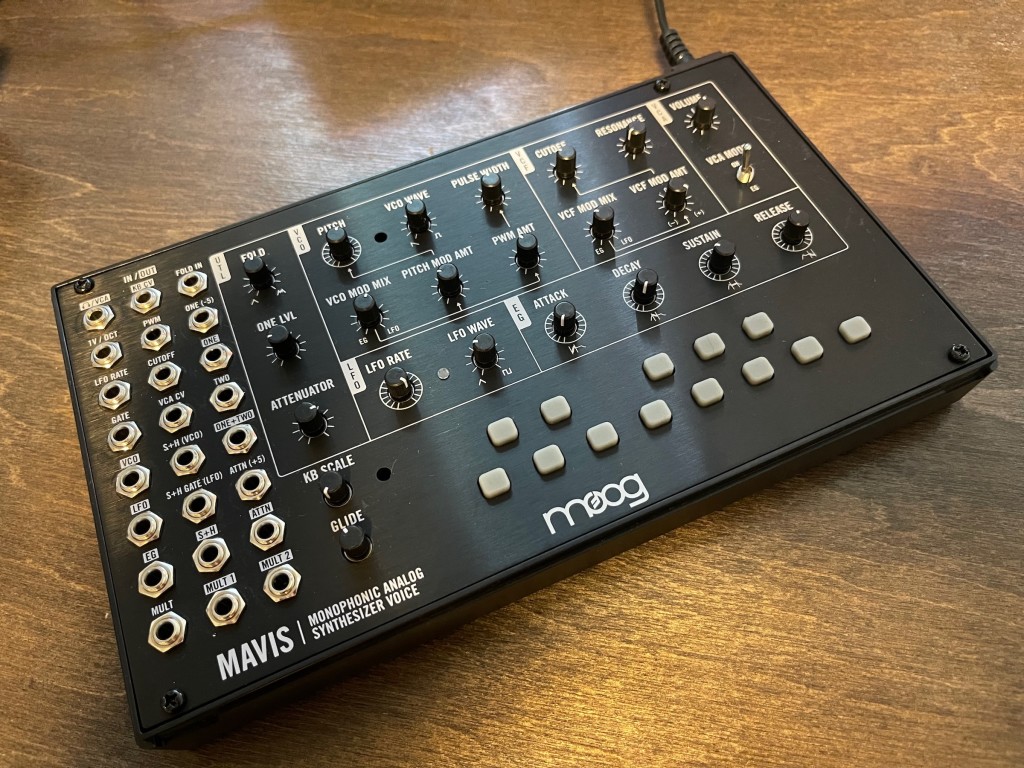
Mavis hands-on
I’ve gotten to spend some time with a review unit of the $349 Moog Mavis, plus had a briefing from Moog in Berlin around Superbooth. It’s a really compact unit you assemble yourself in fairly short order. Once put together, it’s compact as a desk unit – about the size of a paperback novel, or 44HP in Eurorack scale. You can comfortably hold it in one hand. But it’s sturdy-feeling and even those basic pots are smooth and solid, and heavy enough that it stays put while you’re using it.
It’s really the budget price that stands out, of course – closer to Werkstatt in lineage than even Mother-32 or DFAM or Subharmonicon.
And the key here is you can really use it in a number of ways. It is a standalone monosynth with semi-modular patching if you want it to be. Or you can set it alongside other semi-modulars or patchable desktop stuff from Moog and others. Or you can bolt it into a Eurorack rig – it uses the +12V rail and draws no more than 175 mA. Moog are even unveiling a line of patch guides for some of their instruments. (They don’t cover Matriarch, so I’ll try to make up some patches for that.) And yeah, while you’ll see lots of Eurorack in the demos, quite frankly you’ve got serious patching possibilities with even just desktop stuff.
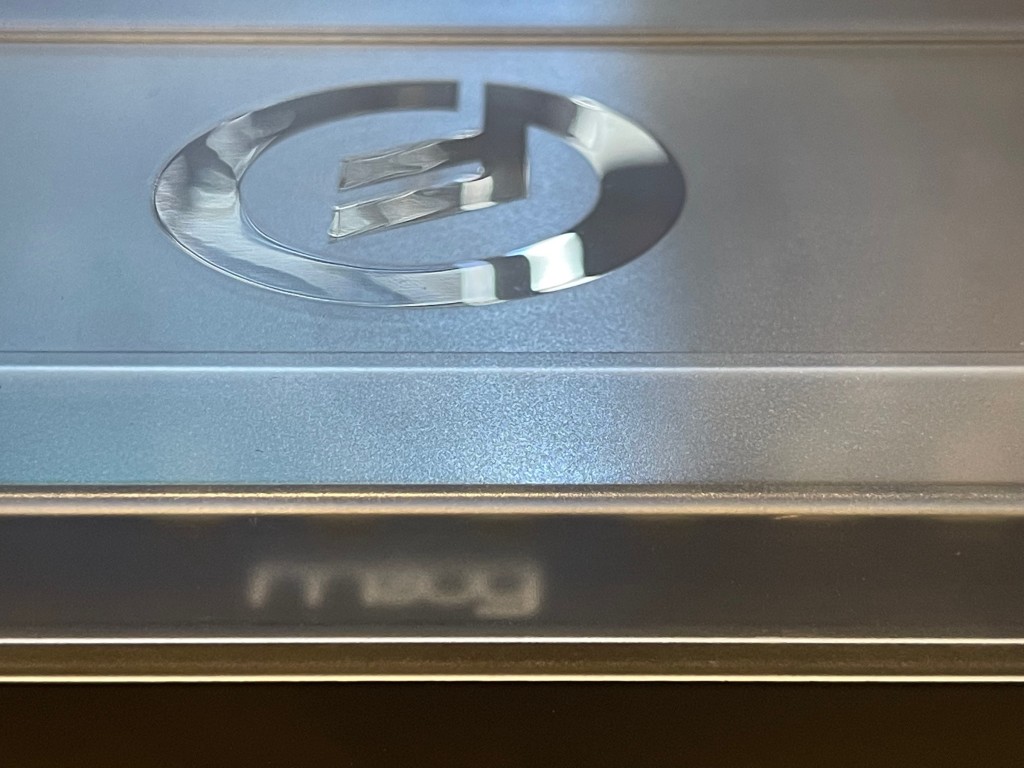
Here’s what surprised me, and what I’ll take a little longer to try to convey in some sound samples for a separate story: this thing can get dirtier than you might think. Oh sure, you think – tiny box, buttoned-down, nice, hipster Moog instrument being polite and traditional and whatever. Actually, with that wavefolder, the low-end response of the instrument overall, and the ability to crank all sorts of (freely patchable) modulation, this thing can get nasty. It’s part of what I liked on the high-end Matriarch, the ability to push the envelope, but it’s even embodied here once you dive into patching.
And that honestly is what had disappointed me about otherwise promising instruments from competing makers lately.
The Mavis doesn’t do everything – no sequencer, for instance, though they do include patches for patching up one, which is sort of the point. (The Subharmonicon or DFAM might solve that, among others – or you could plug an Arturia KeyStep or BeatStep gadget into this, too.) But the efficiency of this little design is also appealing, even if that isn’t obvious to everyone at first.
Let’s break down what it does.
What to know
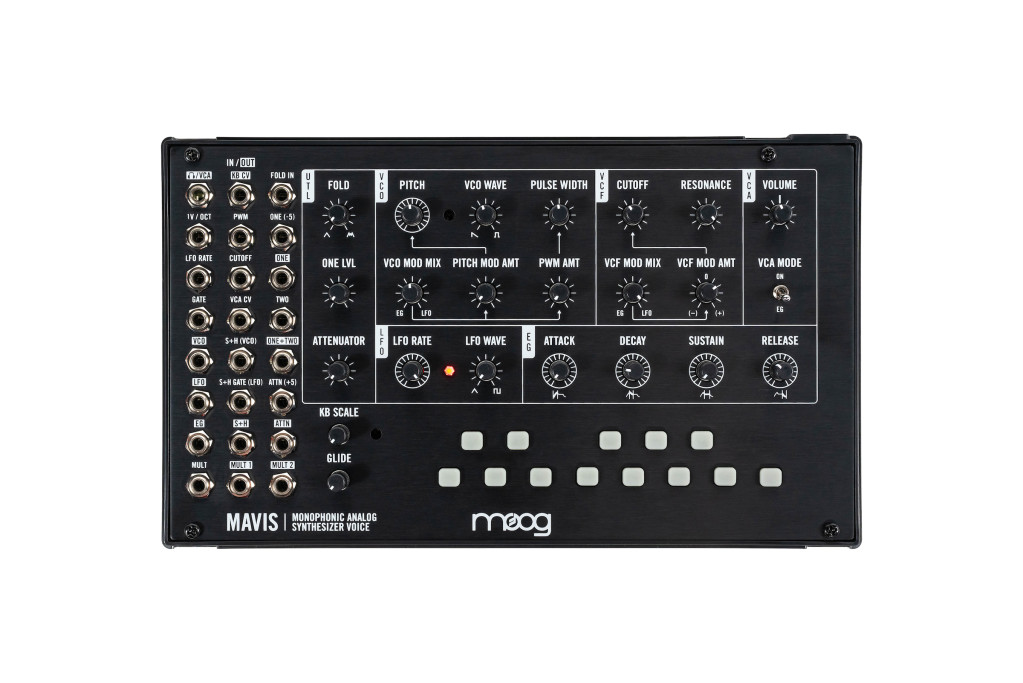
Functions
Mavis really does feel like a baby Moog modular – somewhere between historical Moog modules and more modern renditions. A lot of devices try to pull that off, but this one also has the circuitry to pull off the sound and behavior.
Analog oscillator. 8 Hz – 8 kHz, variable wave shape (SAW – PULSE), pulse width. Add to that pitch and pulse width modulation with variable amount for each, plus the ability to mix both at once (VCO MOD MIX).
Analog filter. Low-pass audio filter – yeah, of course, you get another version of the 4-pole / -24dB Moog ladder filter with resonance. Now here’s where I really wish we had a multimode filter or some twist – I would gladly have sacrificed that keyboard on the bottom. But you get more than just vanilla ladder filtering, thanks to modulation. There’s a bi-polar variable VCF MOD AMT control (meaning you can do inverse modulation), and you can mix modulation from the envelope generator and LFO (VCF MOD MIX), just as on the oscillator.
Filter modulation means there’s no reason to just do plain-boring ladder filter stuff. And that’s even before you start messing with the patch bay.
LFO. Again with variable waveshape, TRI – SQUARE. It’s an audio-rate LFO.
Envelope generator. Attack Decay Sustain Release, patched by default into the amplitude, but also a patchable source.
VCA. The twist here is, you get a VCA MODE switch (as on Matriarch, for instance), so you can make a solid tone / drone, and route LFO and EG elsewhere.
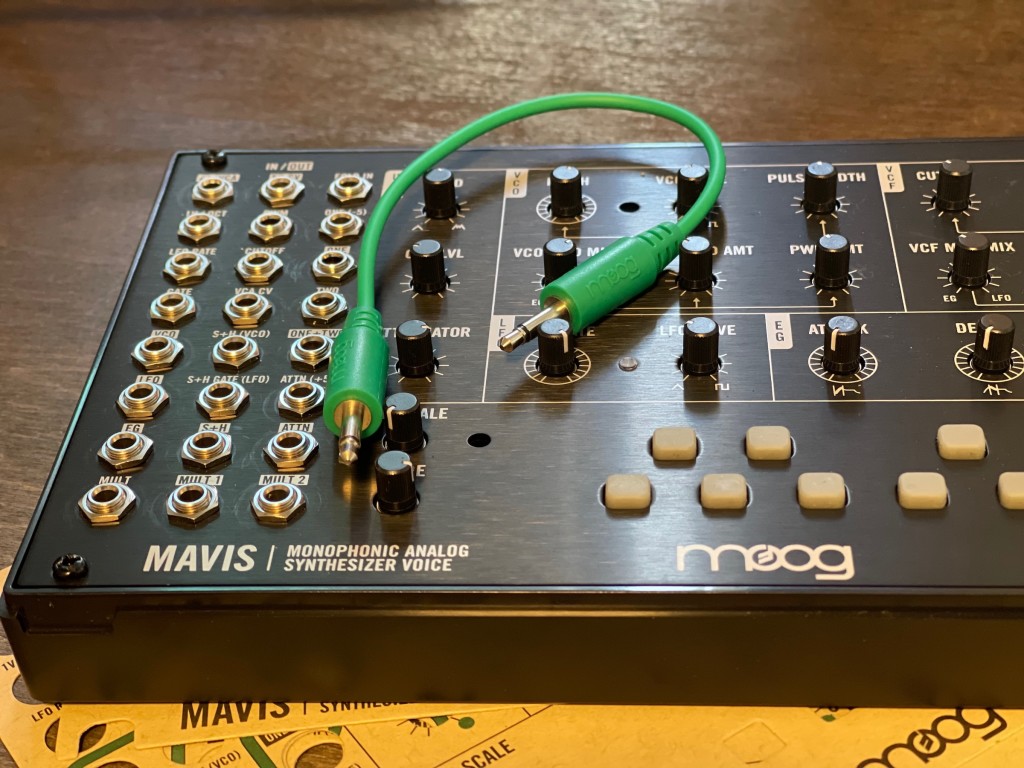
Monophonic keyboard. Soft-touch pads – does what you expect, with scale and glide.
Fold. Here’s where things get interesting. You need to patch this in to hear anything (VCO – FOLD IN being an obvious choice, though there are others). Once you do, you get a very nice (or gnarly, if you want) wavefolder, with a variable control. (Did I turn it up all the way? I did.)
Mixer. This is probably not obvious at all, but the thing called ONE LVL is actually a two-input / one-output mixer. The jacks that say ONE and TWO feed the mixer, and ONE+TWO is the output.
That deceptively simple feature is at the heart of some of the usefulness of the Mavis for patching instruments, especially because the ONE LVL knob you can also potentially overdrive in some pleasant ways, which is something I exploited in my Matriarch patching. And just being able to mix right on the Mavis is handy – whether on an internal patch or in use with another gadget.
Attenuator. Patch into ATTN +5, and you can reduce signal at ATTN out.
Sample & Hold. You won’t see a separate S&H section on the panel, but it’s there – by default, the S&H circuit is driven by the VCO as sample source (meaning the waveform is adjusted with VCO WAVE) and the LFO as the default gate input. But those are patchable to other stuff – see below.
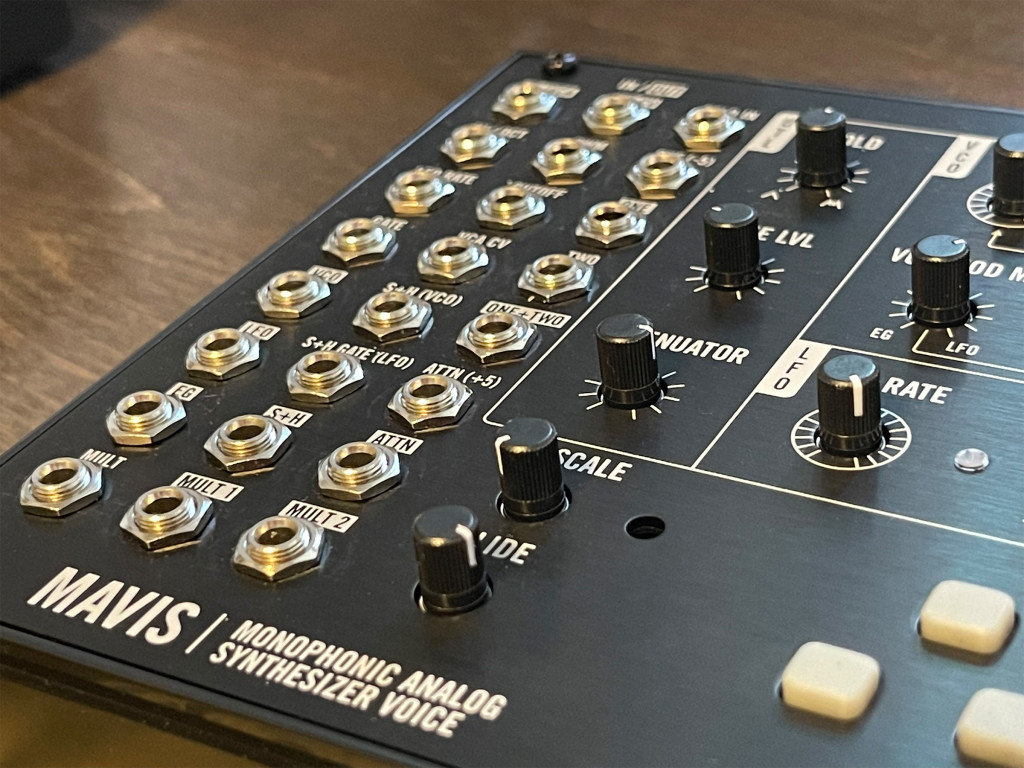
Patch bay
13 ins, 11 outs, outs shown with text on a white background. Here they are:
- Headphone/VCA out
- Keyboard CV out
- Fold in
- 1V/octave (your basic pitch modulation)
- Pulse Width Modulation input
- Mixer inputs ONE, TWO
- Mixer channel 1 output (so if you patch into input ONE, you can also just use the mixer to scale the amplitude of the output at output ONE)
- Mixer output (ONE+TWO)
- LFO rate input
- Cutoff frequency input
- Gate input (triggers the envelope generator)
- VCA input (level of the VCA – so you could use this for amplitude modulation)
- VCO output
- S+H input
- S+H gate input
- S+H output
- Attenuator input (attenuate whatever you like – but even without this patched, the ATTN output jack will give you a control signal of 0-5V based on where you set the attenuator knob)
- Attenuator output
- EG output
- MULT input
- MULT out 1, 2
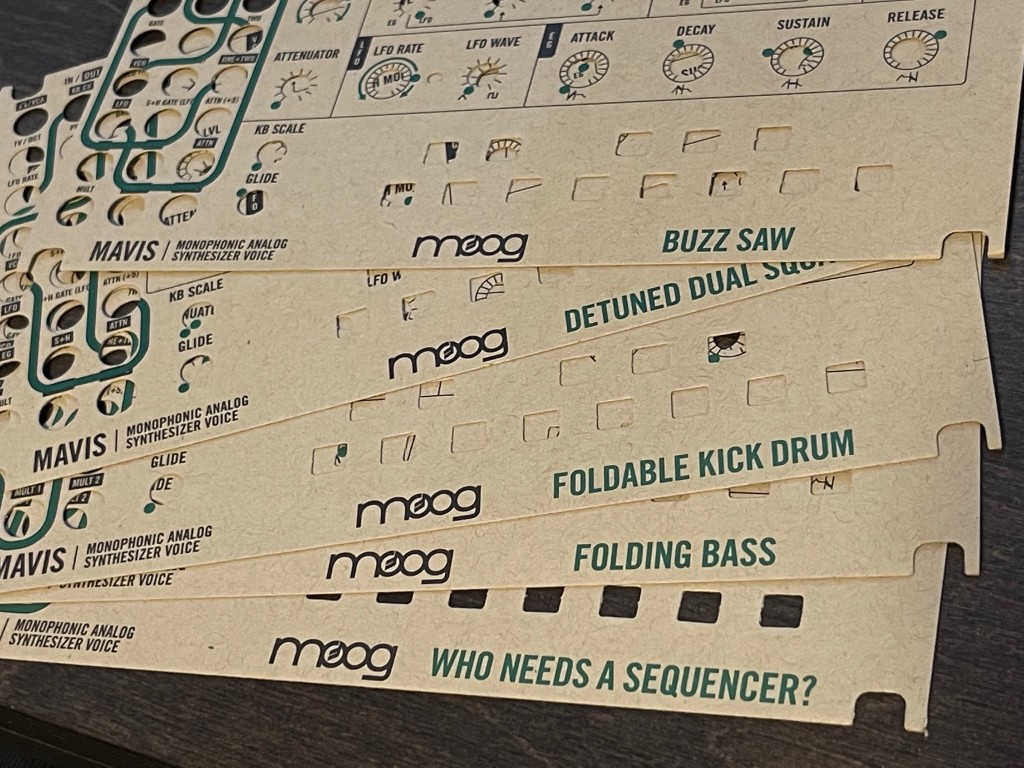
A lot of these are normalled to useful patches already, making Mavis playable right out of the box.
But you’ll see you get a ton of stuff “for free” on this little device – a couple of simple attenuators (MIX ONE and ATTN in/out), a 1×2 mult for duplicating a signal, and a sample & hold circuit. And you’ve got this handy wavefolder. And you’ve got the Mavis’ envelope generator and LFO for adding wherever you need.
So it’s an analog voice you can add to anything, but it’s also a utility module you can add to anything. Do other devices out there do that? Sure. But you’d be hard-pressed to find one as good-sounding, versatile, and well-documented as this little box.
In exchange for that, you do lose some patch points – you can’t patch VCO or LFO waveshape, for instance, that you have to do with the pot. But at this price, it’s hard to complain.
PS – you can recalibrate the 1V/OCT and (even, if you’re really kind of… obsessive) the keyboard to other gear, via included documentation and tool. (Note the holes next to PITCH and KB SCALE.) Most of us will probably be fine leaving it as-is, though.
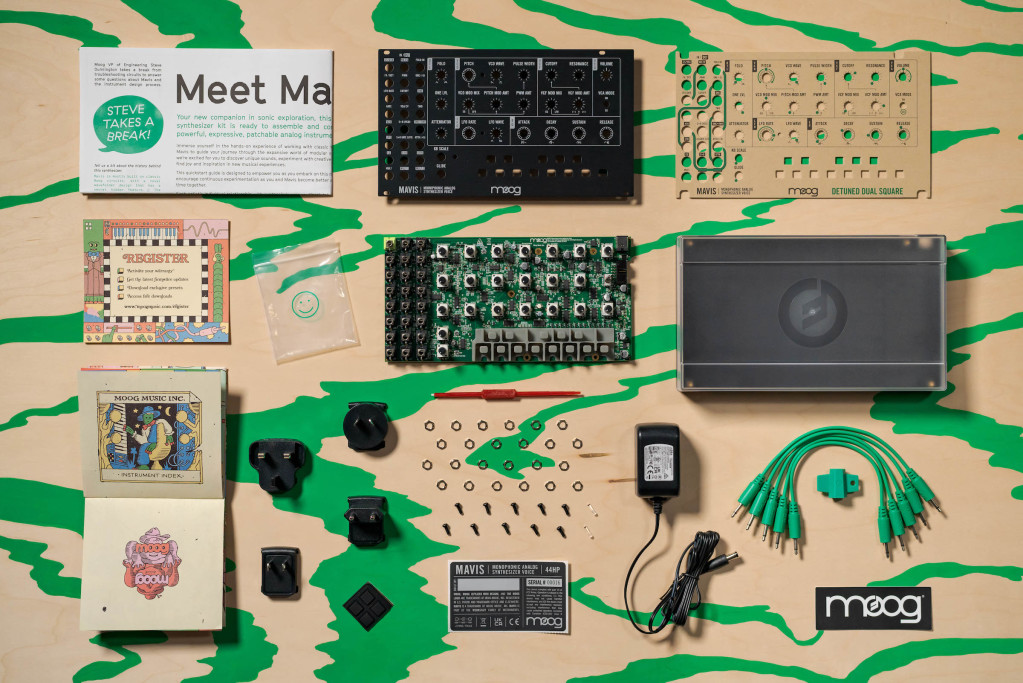
Assembly
Assembly is pretty simple – this is a fast-build job more than a kit per se; you do the whole thing with a Phillips-head screwdriver. The process:
- Attach some stick-on feet
- Attach the PCB to the front panel with screws
- Attach that to the chassis with screws
- Add the hex nuts onto the jacks
And that’s really it. (Okay, there’s a stick-on serial number label.)
What’s included
In the box is the power supply, all the necessary parts, and the calibration tool. Plus, bonus, you get:
- A fitted protective lid
- Some short green patch cords (fine for this on its own, though I think you’ll want a fistful more if you start to get ambitious)
- A pretty poster
- A bunch of patch sheets
- A cute fold-out starter guide with a talk with designer Steve Dunnington, assembly instructions, and basic walkthrough, though you’ll also want to check the (online manual)
- A Moog sticker
There’s a bunch of additional documentation – a “patching with intention” guide online, patchbooks for the Mavis solo and Mavis with Subharmonicon, Mother-32, and DFAM, and a really thorough manual. It’s almost all that additional care that you’re investing in with their gear.
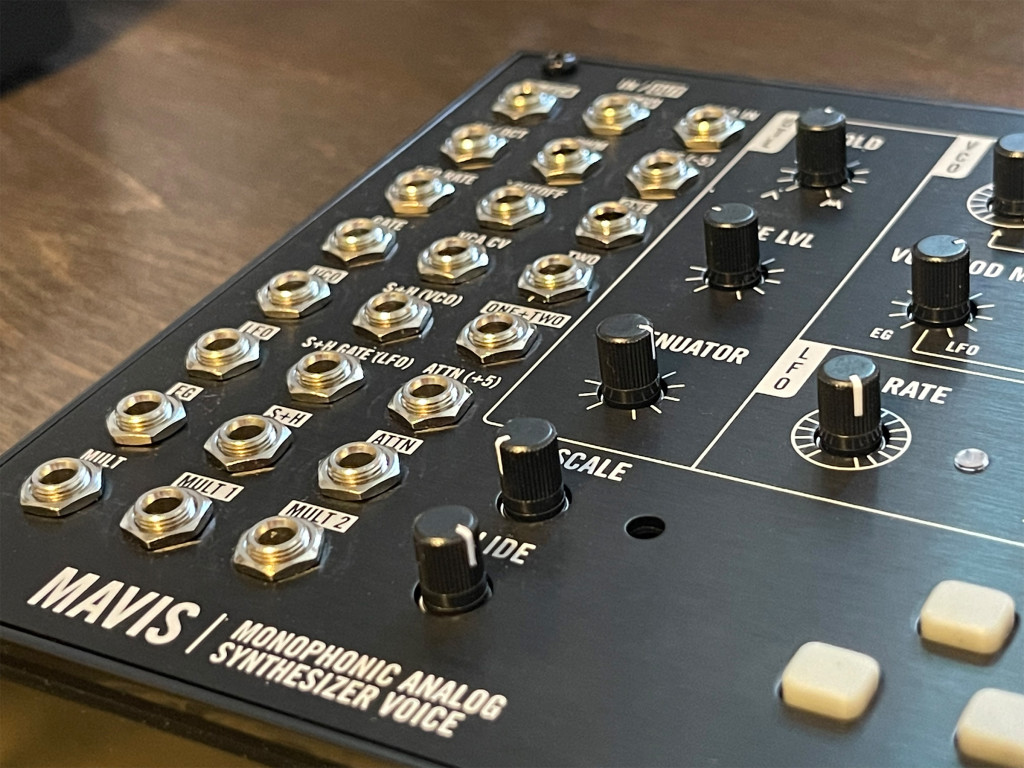
Bottom line
I mean, to me it’s clear what makes this a winner. It could have come out really dull, but adding crossfader knobs on modulation, that delicious wavefolding circuit, and all the utility patch points into a well-balanced package shifts this into must-own territory.
There’s another side to all of this. With the whole industry facing serious production shortages, the other thing I like about the Mavis is that it instantly adds life to any other gear around you want to patch into – at a budget that’s within reach of a lot of people. So even though this has a dust cover, I like the idea that it won’t gather dust – and it could reinvigorate some of the gear you already own that might need brushing off.
It’s probably overkill if you have similar modules around, to be sure. But especially for those of us doing some of our patching in the desktop domain – or anyone missing some of these particular utilities or Moog flavor – it’s an easy call.
https://www.moogmusic.com/products/mavis
Artist demos
The launch video includes some nice artist jams.
Anyone who knows me will not be surprised that I’m partial to Silent Servant and the second Acemo and Arushi Jain compositions, but kudos to Moog for covering a musical spectrum. Now I think CDM needs to do a trashier series where we shoot everything on some awful old DV cam in some grimy environments so everything doesn’t look and sound so… nice.